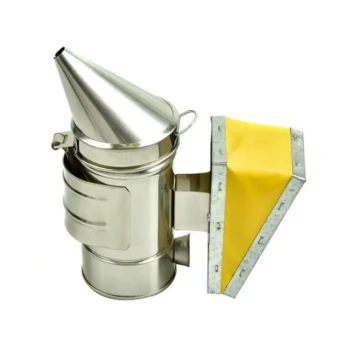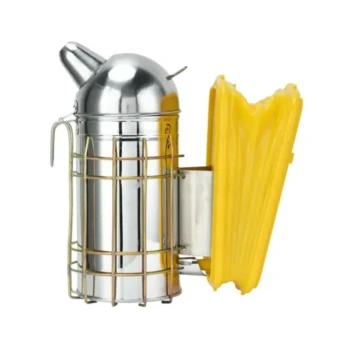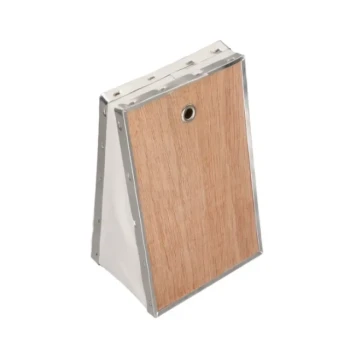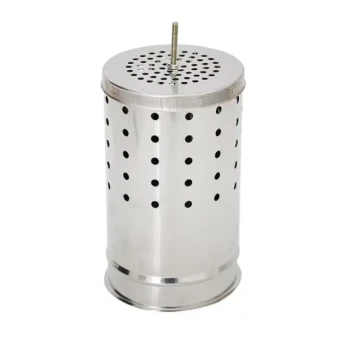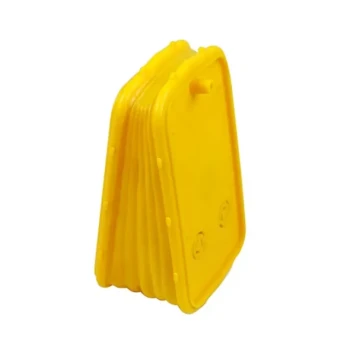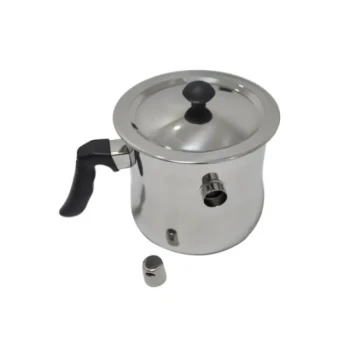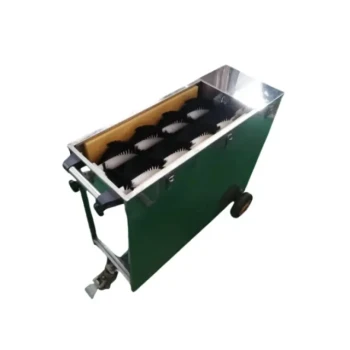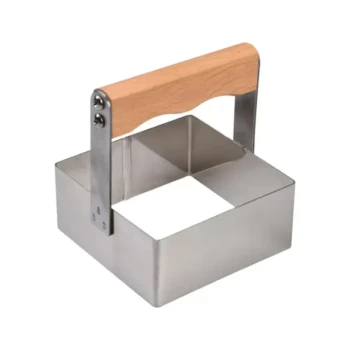At its core, the smoke used by beekeepers is generated by burning a variety of natural, slow-smoldering organic materials. The goal is to create a cool, thick smoke, and common fuels range from burlap and pine needles to specialized commercial products made of compressed cotton.
The specific material burned is less important than its properties. The primary goal is to produce a cool, clean, and consistent smoke that calms the bees by masking alarm pheromones without harming them or contaminating the hive.
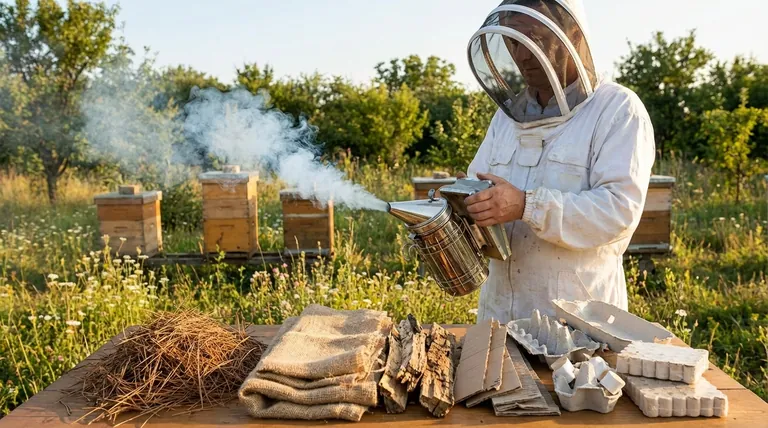
The Principles of an Effective Smoker Fuel
The purpose of smoke is not to sedate the bees but to trigger a feeding response and obscure the chemical signals they use to communicate danger. To achieve this safely, any fuel you choose must adhere to three core principles.
It Must Smolder, Not Burn
A good smoker fuel does not burst into flames. Instead, it smolders, undergoing slow, low-temperature combustion that produces a large volume of smoke with very little heat.
Fuels that burn too quickly or produce flames generate hot, thin smoke that will anger and harm the bees, defeating the purpose of smoking them.
The Smoke Must Be Cool
Hot smoke is seen as a direct threat by the colony and can burn their delicate wings. The fuel and the smoker itself must work together to ensure the smoke that exits the nozzle is cool to the touch.
Materials like burlap, rotten wood, and cotton are ideal because they produce a thick, low-temperature smoke.
The Fuel Must Be Clean and Natural
The hive is a sensitive environment and the honey can absorb airborne compounds. It is absolutely critical that smoker fuel be free of chemicals, pesticides, and synthetic materials.
Burning plastics, treated wood, or printed cardboard with heavy inks can release toxic fumes that are harmful to the bees, the beekeeper, and can contaminate the honey and wax.
Common and Effective Smoker Fuels
While many materials fit the criteria, beekeepers tend to rely on a few trusted categories of fuel, balancing availability, cost, and performance.
Dried Natural Materials
These are often the most accessible and cost-effective options. They include untreated burlap fabric (hessian), dried pine needles, sun-baked leaves, and dry, punky rotten wood. These materials light easily and smolder consistently.
Processed Organic Materials
Everyday items can also serve as excellent fuel. Corrugated cardboard (with all tape and labels removed) and paper egg cartons are popular choices. They must be completely free of plastic, wax coatings, and colored inks.
Commercial Fuels
For convenience, many beekeeping suppliers sell processed fuels. These often come in the form of compressed cotton fiber or blocks of pulped paper. They are designed to be easy to light and provide a long, reliable smolder time.
Critical Pitfalls to Avoid
Choosing the wrong fuel is one of the most common and dangerous mistakes a new beekeeper can make. The consequences can range from an agitated hive to colony death.
Never Use Synthetic Materials
Do not burn anything containing plastic, nylon, polyester, or other synthetic fibers. These materials release toxic chemicals when burned and can produce hot, acrid smoke that will infuriate a colony.
Avoid All Treated or Finished Materials
Never use pressure-treated wood, painted or stained wood, particleboard, or MDF. These materials contain arsenic, formaldehyde, and other dangerous chemicals that create poisonous smoke.
Steer Clear of Green or Wet Fuel
Attempting to burn green leaves, fresh grass clippings, or damp wood will not work. This produces a hot, steamy, and irritating vapor rather than a calming smoke, and it will be difficult to keep the smoker lit.
Making the Right Choice for Your Goal
Your choice of fuel will depend on your priorities, what's available in your environment, and how much time you want to spend preparing it.
- If your primary focus is cost-effectiveness and availability: Use foraged materials like dry pine needles, punky wood, or untreated burlap sacks.
- If your primary focus is convenience and reliability: Purchase commercial smoker fuels like compressed cotton, which are pre-packaged and designed for a long, consistent smolder.
- If you need a readily available backup: Keep clean corrugated cardboard or paper egg cartons on hand, ensuring they are free of any tape, plastic, or ink.
Ultimately, a successful beekeeper learns to produce quality smoke from whatever clean, natural, and dry material is available.
Summary Table:
| Fuel Category | Examples | Key Properties |
|---|---|---|
| Dried Natural Materials | Untreated burlap, pine needles, rotten wood | Accessible, cost-effective, good smolder |
| Processed Organic Materials | Corrugated cardboard, paper egg cartons | Readily available, must be clean |
| Commercial Fuels | Compressed cotton, pulped paper blocks | High convenience, reliable & long-lasting |
| Materials to AVOID | Plastics, treated wood, synthetic fibers | Toxic, produces harmful, hot smoke |
Ensure the safety of your apiary with reliable, high-quality smoker fuel.
As a trusted wholesale supplier to commercial apiaries and equipment distributors, HONESTBEE provides the dependable beekeeping supplies you need to operate efficiently and protect your colonies. Our selection of clean-burning, commercial-grade smoker fuels is designed for consistent performance.
Contact our team today to discuss your wholesale supply needs and discover how HONESTBEE can support your business.
Visual Guide
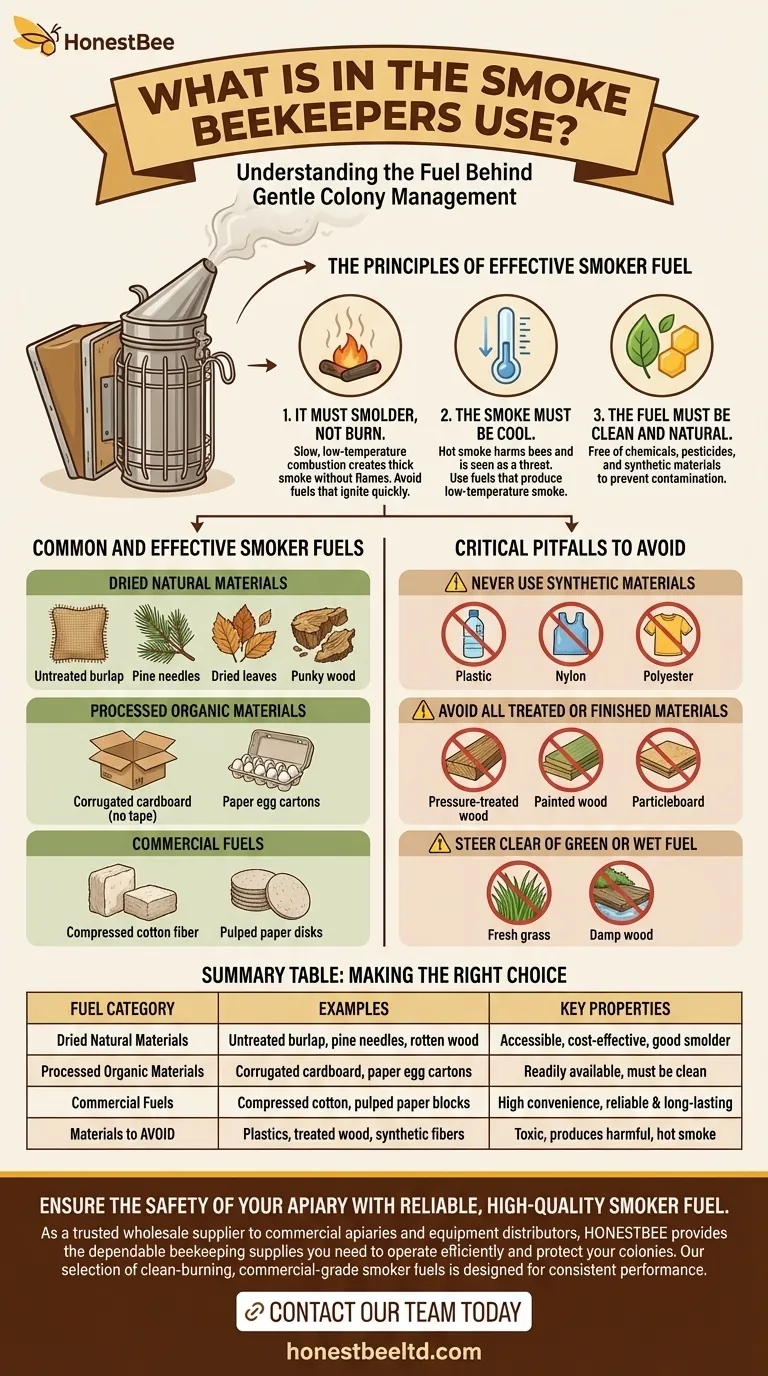
Related Products
- 54-Piece Smoker Fuel Pellets for Beekeeping Beehive Smoker Fuel
- Premium Traditional Copper Bee Smoker with Bellows
- Economy Galvanized Beekeeping Honey Bee Smoker for Wholesale
- Stainless Steel Honey Bee Smoker Hive and Honeycomb Smoker for Beekeeping
- European Stainless Steel Bee Smoker for Honey Bee Hive
People Also Ask
- What is best to burn in a bee smoker? Master the Layered Fuel Technique for Calm Hives
- How should you start the fire in a bee smoker? A Step-by-Step Guide for a Calm Hive
- What fuels are recommended for beehive smokers? Master the Art of Calm, Controlled Inspections
- What is used in a bee smoker? Master the Best Fuels for Calm, Healthy Hives
- What to put in a bee hive smoker? A Guide to Natural, Calming Fuels






